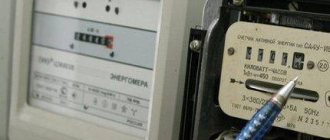Legislation on electricity benefits in rural areas
In 2011, the federal government approved Resolution No. 1178, which sets out the pricing framework for electricity tariffs. According to the resolution, the discount ranges from 0% to 30%. The exact size is determined by the authorities of a particular subject of the Russian Federation.
There are no regions that do not provide electricity benefits for owners of private houses without gas. In addition, in most regions of the Russian Federation there is a maximum subsidy of 30%.
In order to receive a discount on electricity bills in rural areas, you need to prove to the administration that you have an electric stove and heating appliances. To do this, it is enough to register them. There are no other conditions for receiving a discount. A family can have any income level.
Owners of private houses located within the city or other locality can also apply for the benefit. The conditions are the same as for residents of rural areas.
How can residents of the private sector pay for electricity at a lower tariff?
How to reduce the electricity tariff for a non-gasified house in an urban area?
Many people who decided to build their own house often encountered the fact that the site on which the house is being built is not gasified or its gasification is extremely expensive.
In this regard, the question arises: how can I cook food and heat in this house? Of course, there are many ways to organize food preparation and heating at home using an electric stove and electric boiler. But in this case, and especially when organizing an electric heating system, electricity consumption will increase significantly, and therefore, the cost of paying for electricity will also increase. So, how can we reduce the cost of electricity for people who are building a house and cannot gasify it because it is impossible to do so or the price of gasification is too high.
The answer to this question lies in the application of a reduced electricity tariff (preferential electricity tariff), which should be applied in such a case. This preferential tariff for electricity is established by the local executive authority in the field of state regulation of tariffs.
As is known, electricity tariffs for the population, which are established by the local executive authority in the field of state regulation of tariffs, are differentiated for the following categories of the population:
1. For the urban population living in houses equipped with gas circuits;
2. For the urban population living in houses equipped in the prescribed manner with electric stoves (we will briefly call them electricity tariffs for electric stoves);
3. For the rural population (rural tariff).
At the same time, in accordance with clause 2 of the Government of the Russian Federation of December 7, 1998 No. 1444, tariffs for the consumer groups specified in clauses 2 and 3 (urban population with electric stoves and rural population) are calculated by the local executive authority in the field of state regulation tariffs using a reduction factor of 0.7.
In other words, tariffs for the urban population with electric stoves and for the rural population are 70% of the tariffs for the urban population with gas stoves (30 percent less).
We suggest you understand how tariffs calculated using a reduction factor of 0.7 should be applied.
The situation with electricity tariffs for the rural population is as follows:
In accordance with clause 1.1 of Article 10 of the Federal Law of October 6, 2003 No. 131-FZ “Granting municipalities the status of an urban, rural settlement, municipal district, urban district, intracity territory of federal cities of Moscow and St. Petersburg is carried out by the laws of the constituent entities of the Russian Federation” . Consequently, the possibility of using a tariff for the rural population in payments for electrical energy with a supplier is possible if a citizen lives in the territory of a municipal entity, the status of which is defined as a rural settlement.
There is NO separate electricity tariff for houses with electric stoves in rural areas!
What are electricity tariffs for houses with electric stoves and how can city residents get it?
With tariffs for electrical energy for citizens - consumers living in houses equipped in the prescribed manner with electric stoves (electric stove tariff) the situation is as follows:
In this question, everything seems to be clear, but there is one “but”. What is “equipped with electric stoves in the prescribed manner”? Who determined this order and who determines whether everything is done in this “established” order.
In accordance with the explanations of the FTS of Russia, by the concept in the prescribed manner, the FTS of Russia understands that the electric stove was installed for food preparation, and the corresponding project, permit and issuance of technical specifications from the electric grid organization were drawn up. At the same time, it must be physically possible to install the slab. In addition, the electrical installation must be accepted by Rostechnadzor employees. At the same time, independent installation of an electric stove, without carrying out the above actions, does not give the consumer the right to demand the use of a reduced electricity tariff in settlements with him.
Thus, the application of the tariff for the urban population living in houses equipped in the prescribed manner with electric stoves (electricity tariff with electric stoves) is possible if the following conditions are met:
1. The project for electrifying a house must contain a condition that electric stoves will be installed in the house;
2. The technical specifications issued by the network organization must take into account the inclusion of electric stoves in the power supply project;
3. Based on the results of fulfilling the technical conditions, the acceptance of the electrical installation (electric stove) must be carried out by Energonadzor employees.
It is worth noting that point 3 (inspection by Energonadzor) must be performed only by legal entities whose power receiving devices are more than 100 kW. (roughly speaking - to the developer of an apartment building) That is. Citizens-consumers do not require an inspection certificate from Energonadzor.
Summarizing the above, if you are an individual and have decided to build a private residential building in an urban area and, taking into account the technical features of the area, do not have the opportunity to further gasify it, you can decide to install electric stoves and electric boilers for food preparation and want to organize heating of the house with electricity, then to use a reduced tariff in payments for electricity, you need:
1) include an electric stove and (or) electric boiler in the electricity supply project;
2) transfer this project to the network organization, obtain technical conditions for connecting to electrical networks;
3) fulfill the technical conditions, obtain a certificate of technological connection;
4) contact the guaranteeing supplier with a written application to conclude an energy supply agreement and in the application indicate the need to carry out calculations with the tariff for electric stoves.
After this, you will be able to significantly reduce energy costs and use the electricity tariff with electric stoves (electric stove tariff) in your calculations.
Is it possible to get a discount on heating with electricity if you have gas?
The size of the discount for owners of private houses is established each year by the local committee on prices and tariffs. Otherwise, this department can be called the regional energy commission. They establish the amount of benefits for 2 categories of the population - basic and those who have electric stoves in the prescribed manner.
The basic category includes all people who live in private houses. Usually there are no benefits for electricity payments. To fall into the category of citizens who have electric stoves in the prescribed manner, it is enough to purchase the device and register it. It doesn't matter whether there is gas in the house or not. To receive the benefit, you only need to use an electric stove.
The process of designing an electric stove and other appliances depends on the region. For example, in the Moscow region it is enough to have a passport for the stove and an installation certificate.
Where to begin
First of all, you need to pay attention to the capabilities of the electrical network. Typically, for electric stoves, a power of 10 kW is considered sufficient (minimum - 8). In old-plan houses, the average load is up to 5 kilowatts. The owner of the apartment will need to contact Energosbyt at his place of residence and inquire about the likelihood of increasing electricity capacity. If a higher load is not possible, you will have to purchase a new cable yourself and negotiate with power engineers to have specialists install it.
Advice! An alternative could be a low-power (2 - 2.5 kW) electric stove with two burners.
How to design an electric stove in rural areas
In many regions, the process of designing an electric stove is complex. You will need to collect a lot of documents and acts. First of all, to install the stove you need to obtain permission from the local branch of Rostechnadzor. Then receive the following documents:
- Rostechnadzor act on permission to operate electrical installations;
- act of accession;
- technical plan of a private house;
- technical passport of the slab;
- statement from the owner.
You must apply for permission to install an electric stove at home from your local authorities. Most often, this issue is dealt with in the committee on prices and tariffs. In some regions, authorities still do not give electricity benefits to owners of houses that have gas. For example, in the Kaliningrad region the following rules apply.
Residents of this region can apply to the state government to receive benefits. To apply for a subsidy to pay for electricity, you need to provide a certificate confirming the absence of gas in the house. To know exactly the required list of documents, just call your local energy sales office and ask about it.
Source
Redevelopment development
To change a gas appliance to an electric one, you will need a new floor plan. All changes must be made to the technical passport. The project must be completed before all work begins.
Great luck for the owner who decides to replace the hobs will be the failure of the entire entrance (or better yet, the house) from gas appliances. In this case, dismantling the slabs and pipes will be easier. But, as practice has shown, many residents do not consider it necessary to switch to an electrical installation.
How to switch to the tariff for houses with electric stoves on an individual basis?
Let's consider a practical situation: a gasified apartment building, the apartments are equipped with gas stoves and gas water heaters. Let’s assume that the owner of one of the apartments decided to stop using gas appliances and switch to cooking and heating water using an electric stove. At his request, the gas service officially turned off the gas in the apartment, and an electric one was installed along with the gas stove.
Question: in this case, does the owner have the right to pay for electricity at a preferential tariff?
The answer is: it does, if the apartment is equipped with an electric stove in the “established” manner. In practice, this means that the owner of the apartment must have a document issued by the local BTI, which states that the apartment is equipped with an electric stove.
To make the necessary changes to the technical passport of an apartment, you need to go through a rather complicated procedure. It will involve:
- Housing inspection. It is the housing inspectorate that is responsible for approving the redevelopment (re-equipment) of residential premises
— Management company of an apartment building. The fact is that installing an electric stove will require the allocation of additional electrical power for the apartment and changes to the house electrical networks. The Criminal Code is responsible for these issues.
— The electric grid company from whose infrastructure the apartment building is connected. The power grid must agree on the allocation of additional power for an apartment switching to an electric stove.
If you follow all the rules, the algorithm of actions will be as follows:
First. A project must be developed for the reconstruction of the electrical network in the apartment (or, officially speaking, the electrical installation of the apartment), as well as parts of the house electrical networks, taking into account the increase in power consumption
Second. This project must be agreed upon with the management company of the apartment building
Third. It is necessary to submit an application to the electric grid company to increase electrical capacity, attaching the consent of the management company. In response, electric networks are required to issue a draft agreement to increase the allocated electrical capacity and technical conditions for it.
Fourth. With these documents, you must contact the housing inspectorate and obtain permission to re-equip the apartment there.
Fifth. If approval is obtained, work can be carried out on the electrical networks of houses and apartments. Their results are confirmed by an act on the allocation of additional capacity (signed with the electric networks and the management company), as well as by acts of delimitation of balance sheet ownership and operational responsibility (signed with the management company).
Sixth. Having all these documents in hand, you need to contact the BTI and make changes to the technical plan of the apartment and the entire house.
Seventh. Having those in hand. apartment passport confirming the presence of an electric stove, as well as the above acts, the owner contacts the energy sales company to apply for a preferential tariff.
Is it possible without approval?
Replacing the stove yourself is considered illegal and is fraught with many problems. Imagining the future troubles, many decide to take the easy way out by turning off the tap on the gas pipe and replacing the stoves (from gas to electric) on their own. Do not forget that such arbitrariness is considered illegal and can bring many problems. In the future we expect:
- the possibility of a loose valve fit and gas leakage;
- fire of wiring in case of excessive load on the electrical system;
- the difficulty of selling an apartment in the future without the appropriate documents for redevelopment;
- responsibility for independent dismantling and arrangement in apartment buildings.
Fines have been established for illegal changes in housing layout; the minimum penalty is 2,000 rubles . In the event of a switchboard fire due to the fault of the electric stove installer, in addition to monetary sanctions, you will need to replace the wiring and pay for repairs. In case of fire or explosion of domestic gas, criminal liability is provided.
If you decide to replace a gas installation with an electric one, you should not be afraid of contacting special bureaus. After all, home improvement is done for many years.
Advice! If someone does not have time to run through the authorities, they can entrust this matter to a knowledgeable specialist. A knowledgeable lawyer will quickly resolve all issues and sign the necessary documentation.
Connection to a three-phase line
Everything is the same here, however, with the exception of several components:
- You will need a five-core cable (instead of a three-core):
- 3 wires, one for each phase;
- 1 core – to zero;
- 1 core - for grounding.
The cores are attached to each phase separately. We no longer need any jumpers here. You should be careful when connecting the cable in the panel and connecting the same cable to the socket at the other end. It is vitally important to observe the color coding of the cores so as not to accidentally connect a cable corresponding to zero or grounding in the panel to the phase socket in the socket. (It is recommended to write it down.)
- You will need a three-phase power socket and an SSI-125 plug, designed for a rated current of 32 Amperes. The operating voltage of such an outlet is 380 Volts. Therefore, you should be especially careful with it during installation and startup. Degree of protection – IP It is secured with four self-tapping screws.
Dismantling a gas stove and connecting an electrical appliance
GorGaz is responsible for disconnecting residential premises from gas supplies. You will need to come here with a technical passport and write a statement about the failure of the gas stove. The organization for the supply of “blue fuel” will send craftsmen. They will remove the pipes through which gas was supplied to the stove and install a plug. Officially, housing is considered cut off from gas supply after the act is signed.
Plug on gas pipe
If the apartment is not on the top floor, it will not be possible to completely remove the gas riser, since gas flows through a common pipe to other dwellings, the owners of which do not intend to exchange gas stoves for electrical equipment
Important! When installing an electric stove, you will need a separate cable and a three-phase socket.
Preparing the wiring
It was no coincidence that the conversation about wiring came up at the very beginning of the article. Firstly, the security of the entire system depends on it. It is necessary not only to correctly select wires with the required cross-section of cores and the material from which they are made, not only to correctly build cable channels, but also to correctly connect the circuit, depending on the selected type. Secondly, when connecting an electric stove, 98% of the total time will be spent organizing and monitoring the correct connection of this device to the network. So, when talking about connecting the stove, we mean proper installation of the electrical circuit.
Read more: Inheritance after the death of parents without a will
So, electrical circuit diagrams are divided into 2 main types:
Loop wiring
With this organization, the cable returns back to the power panel. It turns out that all electrical appliances that will be powered from this cable will be connected to each other in series. However, we all know that parallel connection of consumers is practiced in everyday life. This is what makes it possible to withstand a voltage level at any point in the wiring equal to 220 Volts. Almost all electrical devices are designed to work with just this voltage, and any deviation gives rise to an off-design mode of operation (which is not covered by the warranty during repairs). What can a serial connection be useful for? There may be several reasons:
- Physical limitation on power consumption. The situation of an individual residential building is considered. These are built mainly outside the city, and sometimes there the situation “with light” is not a fountain. Either some kind of limit is administratively imposed on the house, or a power take-off limiter is installed, or there are simply no extra kilowatts in the network. In other words, if there is a situation of energy shortage, then it makes sense to connect some devices that could potentially operate at reduced voltage in series.
- The need to reduce the operating voltage in each consumer. Sometimes it makes economic sense to use less powerful appliances (for a variety of reasons). A serial connection allows you to lower their voltage, reducing the intensity of energy consumption.
The loop chain provides a significant safety benefit. It is limited in power, and most importantly, the current flowing in it will always be constant. Therefore, the consequences of a short circuit are much less destructive.
An electric stove connected in this way will lose power (i.e. heating intensity) if other consumers are connected to the same circuit. In general, electric stoves with a power of no more than 3 kW are usually connected to loop-shaped (ring) circuits. The plug plug (like the entire circuit) must withstand a current of 13 Amperes. In situations of energy shortage, it is recommended to connect only heating devices to such a circuit.
Beam wiring
This is a two-core wire familiar to us all, the wires of which are connected to different contacts of the sockets. It provides parallel connection of all consumer devices. This ensures stability and calculated operation of all electrical devices involved. The circuit is capable of providing you with as much power as there are consumer devices connected to the network (within the limits of the wire conductor capacity, of course).
When organizing circuits of both types mentioned, an electrical cable must be used with grounding. It should also be borne in mind that to power the slab with radial wiring, you should use a cable only with copper conductors (however, this is desirable everywhere), with a cross-section of at least 6.0 mm2. The cable must withstand a current of at least 40 Amps.
Connection to a single-phase line
In general, electric stoves are connected to one-, two- or three-phase lines. It all depends on the maximum power that is consumed by the totality of all burners of an electrical appliance. The simplest is a single-phase connection. In this case, the cable will have 3 wires:
- Phase wire;
- Neutral wire;
- Ground wire.
The phase wire is connected to one of the three phases in the panel; zero - to the zero terminal, as well as grounding - to the corresponding contact in the switchboard. Grounding is, in fact, a fuse that can take on the load for some time if a defective contactor in the circuit (i.e., a faulty electrical appliance) puts an electrical load on the housing and, in general, third-party electrically conductive objects (for example, the human body). There is no particular point in diving deeper into the physics of grounding, because... all we need to know about this is that this vein is responsible for your safety.
The sequence of actions for the correct order of connecting an electric stove to a single-phase line should be as follows:
- You should always start by de-energizing the circuit in the panel. In addition to the click of the machine responsible for powering the circuit feeding the stove, it is strongly recommended to turn off the power to the entire panel. A general switch is usually installed in the circuit in front of the meter. After switching off, check the presence of voltage at the phase terminals using a signal screwdriver.
- The phase terminals should be prepared for connecting the supply core of the stove cable. Included with the stove (mandatory) are special jumpers that combine all 3 phases in the panel into one. The jumper is a copper cable with three terminals for each phase and one to which the stove cable will be connected. The cross-section of the jumper conductor cannot be less than 6.0 mm2. Modern versions of jumpers are a kind of rigid bridge, covered with insulation on top to protect against accidental contact with human hands.
- Next, we connect the above-mentioned 3 wires of the plate wire to the corresponding terminals in the panel. The ends of the wires of the cable cores should not be tinned (i.e. soldered together). The terminal screws are tightened in two steps: first lightly, then until they stop (until the screw is able to rotate).
It is through this cable that high power currents with a fixed voltage of 220 Volts will pass. This means that increased power will be reflected in increased current, which causes the cable to heat up. The solder typically used for tinning is not a heat-resistant material, so it will inevitably soften and swell, taking on a more favorable shape with less screw pressure on the terminal. In other words, gaps will begin to appear at the point of contact, which will begin to produce a spark over time. As a result, this can lead to an outbreak and fire in the shield.
- The three-pin socket for the stove is mounted on the wall, above the level of the stove and a possible table nearby. It is recommended to take the level of the tap outlet in the sink as the minimum level below which it cannot be installed. The sink itself should be located more than 1.5 meters from the outlet. With all this, the radius of the outlet relative to the stove is limited by the length of the wire (which comes with the electrical device).
- After installing the socket, you should give test power by turning on the switch and the circuit breaker in the panel. If no emergency phenomena have occurred, then most likely the socket is connected correctly and you can proceed to the next step, for which you should again turn off the circuit breaker and the general power switch.
- Next, connect the plug of the stove to the socket.
- Then, preferably wearing rubber gloves, we use a tester to make sure that there is no “ground” on its body (i.e., the grounding fulfills its function, and touching the stove will not give you an electric shock). The check should be carried out for all operating modes of the stove, for each burner.
Under no circumstances should electrical appliances be grounded by connecting them to metallic communications of the building, such as water supply or heating pipes. In addition, you should definitely make sure that the building body is also grounded (it is quite possible that you will have to contact specialized specialists for this).
- If everything is fine and there is no short circuit, then you can reapply power to the panel to check the operation of the device.
- You need to check the functionality in the same way as with a grounding tester: each burner and in all modes. If there is an oven, then you should focus on it, because... it consumes the most energy.
- If everything corresponds to your ideas about proper functioning, then the stove can be confidently “put into operation.”
Read more: Medical examination for teachers, list of doctors and tests











